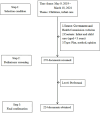Division of childcare policy actors under health-oriented goals: thematic analysis of China's policy texts from the social constructionist perspective
- PMID: 39726654
- PMCID: PMC11669674
- DOI: 10.3389/fpubh.2024.1454537
Division of childcare policy actors under health-oriented goals: thematic analysis of China's policy texts from the social constructionist perspective
Abstract
Background: Ensuring child health, as a key objective of global childcare policies, requires coordinated efforts between the government, social organizations and communities, institutions, and families. Despite China's progress in comprehensive childcare policy development, rapid economic growth, and urbanization, challenges persist, such as urban-rural disparities and unequal resource distribution, highlighting the need for effective collaboration between policy actors.
Methods: To collect textual data, this study searched for prefectural-level childcare policy texts issued since 2019 on government websites and legal databases, ultimately identifying 224 documents for analysis. This study reviewed the literature on the impact of childcare policies on child health and identified the enhancement of childcare quality as a current research focus. This study then conducted a content analysis using Nvivo12 Plus software and coded and analyzed the childcare policy content. Finally, it applied social construction theory to interpret the policy documents.
Results: Childcare policies were centered around child health and formed a responsibility and accountability framework between the government, social organizations and communities, institutions, and families, whose action shares accounted for 38.9, 22.89, 29.05, and 9.16%, respectively. The development of childcare institutions was a key aspect of the defamilialization trend. Compared to other policy actors, institutions played a larger role in child health policy aspects such as safety management (12.97%), health and hygiene (8.56%), and scientific parenting (10.93%).
Conclusion: Within China's health-oriented framework, the refamilialization and defamilialization processes coexist in terms of childcare policies, and limited community-based childcare resources extend beyond the family. The participation of diverse policy actors in China's childcare system is expected to persist, underscoring the increased need to enhance the policy actors' negotiation skills and bolster community-based childcare services in the future.
Keywords: China; childcare policies; health-oriented goal; policy actor; social construction.
Copyright © 2024 Li and Li.
Conflict of interest statement
The authors declare that this research was conducted in the absence of any commercial or financial relationships that could be construed as potential conflicts of interest.
Figures
Similar articles
-
Mapping social accountability actors and networks and their roles in water, sanitation and hygiene (WASH) in childcare centres within Nairobi's informal settlements: A governance diaries approach.PLoS One. 2022 Nov 15;17(11):e0275491. doi: 10.1371/journal.pone.0275491. eCollection 2022. PLoS One. 2022. PMID: 36378662 Free PMC article.
-
Medical Insurance Information Systems in China: Mixed Methods Study.JMIR Med Inform. 2020 Sep 1;8(9):e18780. doi: 10.2196/18780. JMIR Med Inform. 2020. PMID: 32673209 Free PMC article.
-
The challenge of healthcare big data to China's commercial health insurance industry: evaluation and recommendations.BMC Health Serv Res. 2022 Sep 22;22(1):1189. doi: 10.1186/s12913-022-08574-2. BMC Health Serv Res. 2022. PMID: 36138390 Free PMC article.
-
The 2023 Latin America report of the Lancet Countdown on health and climate change: the imperative for health-centred climate-resilient development.Lancet Reg Health Am. 2024 Apr 23;33:100746. doi: 10.1016/j.lana.2024.100746. eCollection 2024 May. Lancet Reg Health Am. 2024. PMID: 38800647 Free PMC article. Review.
-
Advancing knowledge of One Health in China: lessons for One Health from China's dengue control and prevention programs.Sci One Health. 2024 Nov 8;3:100087. doi: 10.1016/j.soh.2024.100087. eCollection 2024. Sci One Health. 2024. PMID: 39641122 Free PMC article. Review.
References
-
- Lokteff M, Piercy KW. “Who cares for the children?” lessons from a global perspective of child care policy. J Child Fam Stud. (2012) 21:120–30. doi: 10.1007/s10826-011-9467-y - DOI
-
- Wüst M. Universal early-life health policies in the Nordic countries. J Econ Perspect. (2022) 36:175–98. doi: 10.1257/jep.36.2.175 - DOI
-
- Ellingsæter AL, Kitterød RH, Lyngstad J. Universalising childcare, changing mothers’ attitudes: policy feedback in Norway. J Soc Policy. (2017) 46:149–73. doi: 10.1017/S0047279416000349 - DOI
-
- Urmańska-Maruszak A, Suwada K. Familialisation of care in European societies: between family and the state In: Castrén AM, Česnuitytė V, Crespi I, Gauthier JA, Gouveia R, Martin C, et al., editors. The Palgrave handbook of family sociology in Europe. London: Palgrave Macmillan; (2021). 205–21.
MeSH terms
LinkOut - more resources
Full Text Sources
Medical





